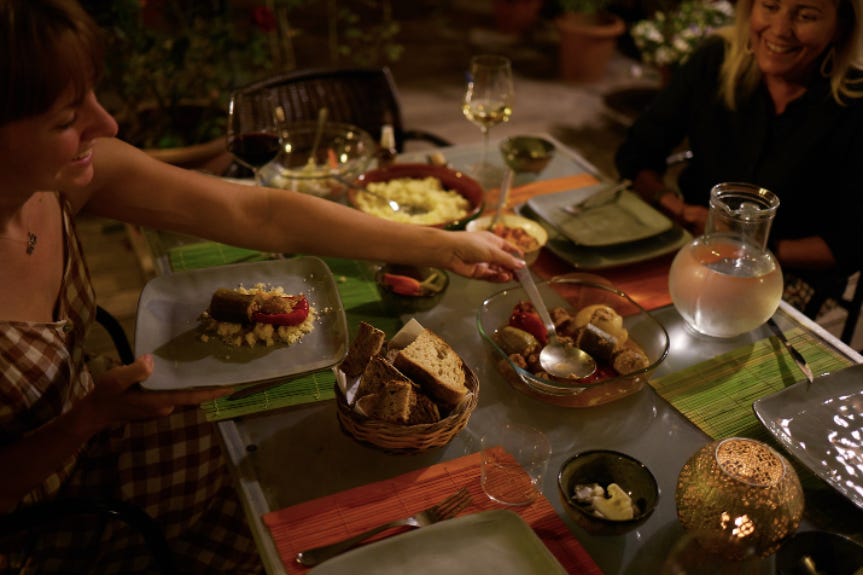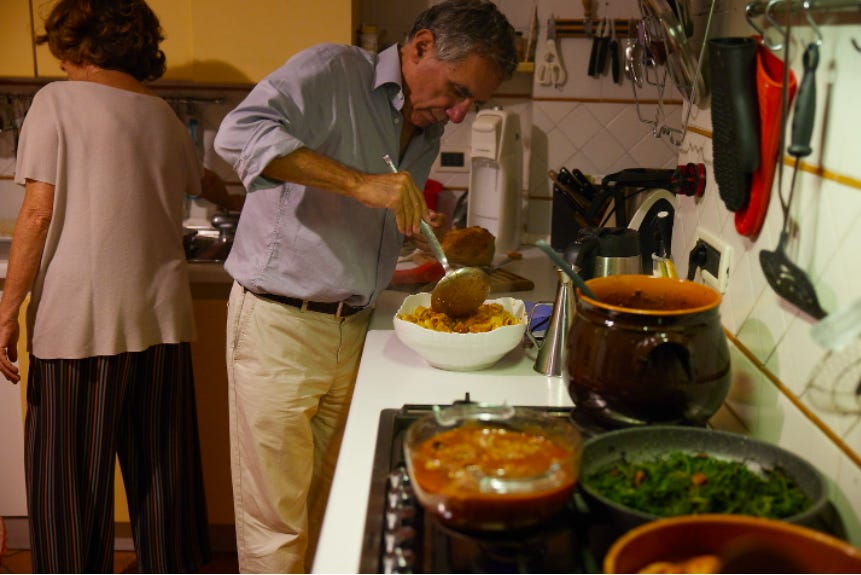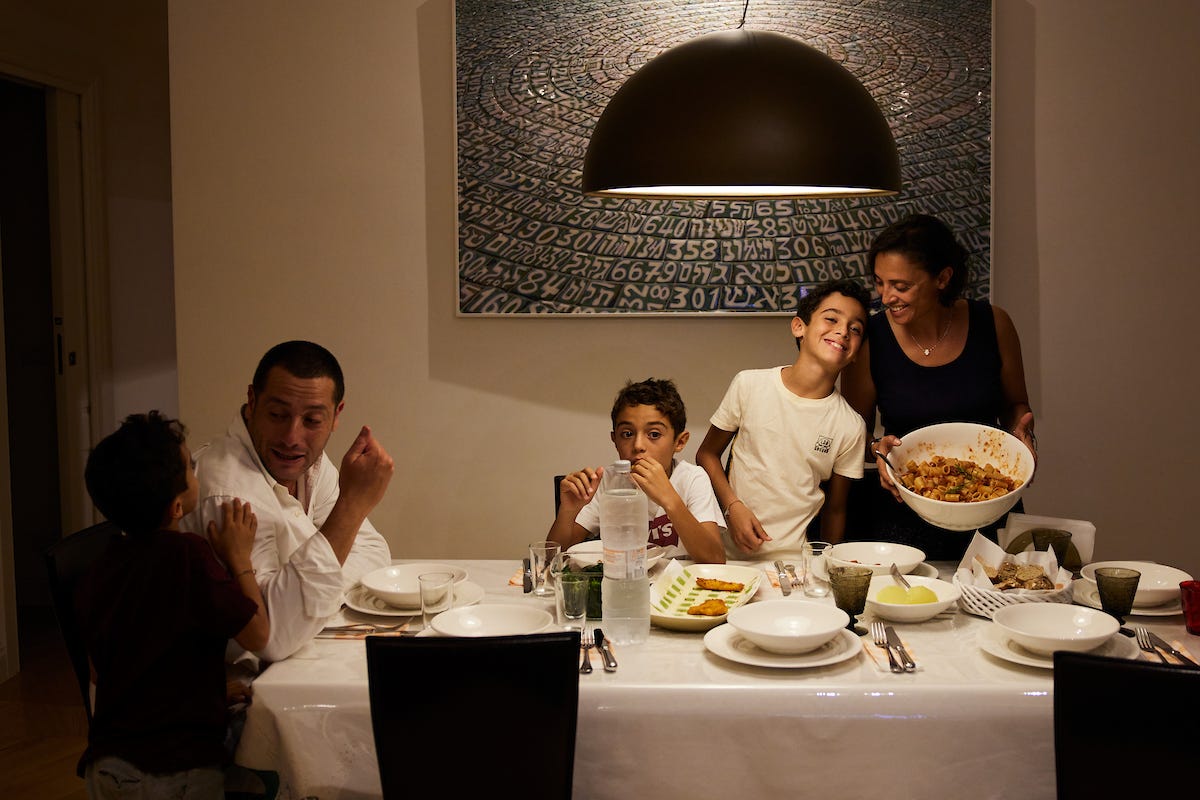Hey there! If you’ve found your way here but are not yet subscribed for the weekly newsletter, you can do that here. You will never miss a recipe or a story, and I’ll be eternally grateful for your support.
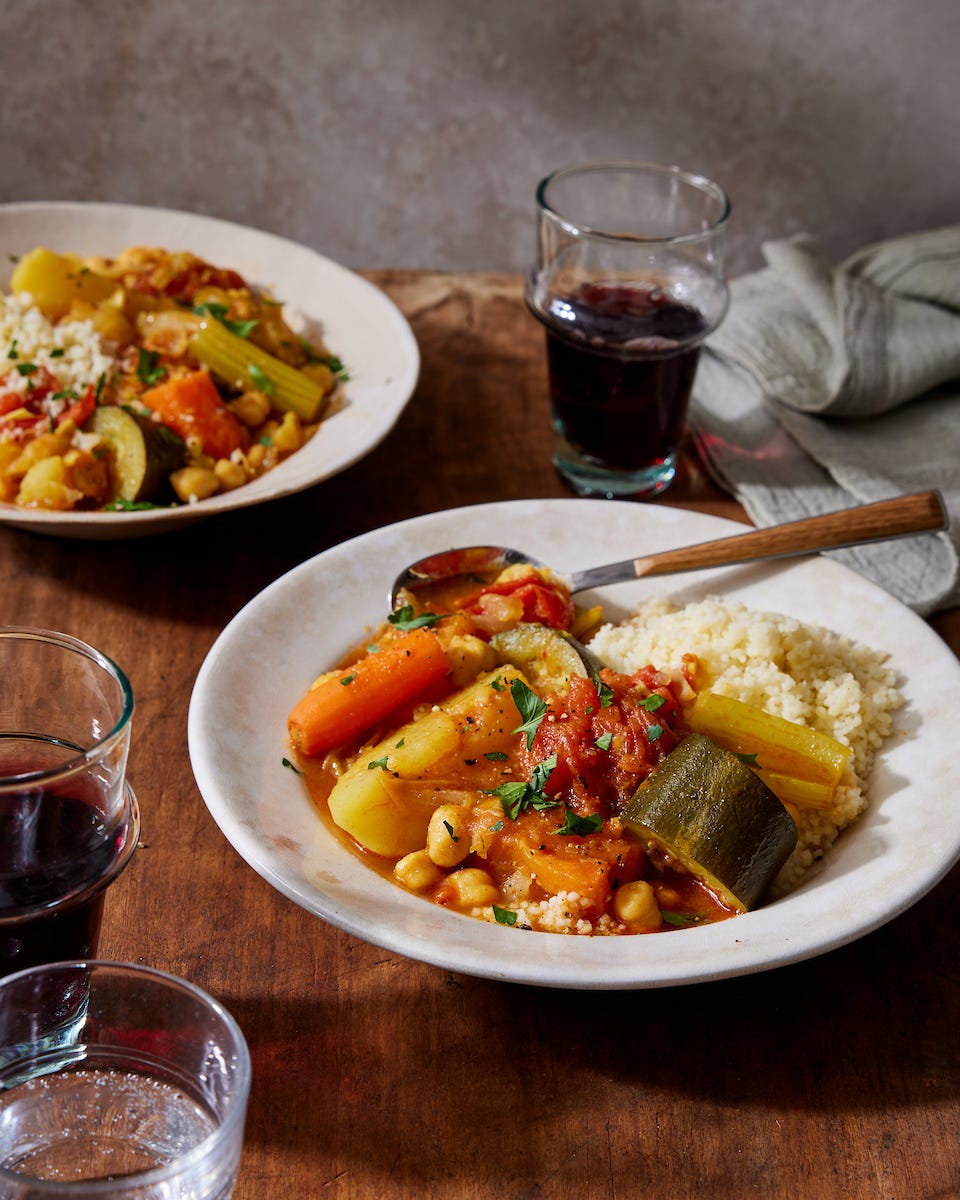
Autumn has come in like a lion here in New York—a soggy, blustery, pull-on-an-extra-pair-of-socks lion. Meanwhile, with Yom Kippur’s fast behind us, we are well on our way to Sukkot, the Jewish calendar’s fall harvest bonanza. Yoshie recently purchased a bunch of PVC pipes to construct a DIY sukkah on our tiny Brooklyn terrace. And I have been craving (and making) all the soups and stews—especially the Vegetable Stew for Couscous from Portico.
The recipe hails from the Libyan side of Rome’s Jewish community. In the late 1960s, several thousand Jews from Libya immigrated to Rome, bringing their love of garlic, chilies, and comforting stews served over couscous with them. And while they are a newer thread in Rome’s 2,000 year old Jewish tapestry, their North African traditions and foodways have begun to be incorporated into the larger Roman Jewish community.
This stew is absolutely perfect for Sukkot. It’s warm, comforting, chock-full of fall veggies, and flavored with warming spices like turmeric and cinnamon. And as you can see from the photo above, it would make a show stopping side dish or vegetarian-friendly main course for your sukkah’s table. (If you’re gluten free, serve it over quinoa instead of couscous.)
There’s a bit—okay, a bunch—of chopping involved to make it, but it is absolutely worth the effort. I like to put on one of my favorite podcasts (like this, this, or this) while getting the chopping part done. After that, everything simmers together, completely hands off, for about 40 minutes allowing the vegetables to soften and the flavors to meld together. You can serve it right after you make it, or keep it in the fridge for a couple of days. (It also freezes well.) Find the recipe below, after a few thoughts on my obsession with seeking out Jewish communities when I’m traveling.
Seeking Out Jewish Tables Abroad
In Portico’s introduction, I share a story about a Shabbat dinner in Rome that changed the trajectory of my life:
“We lucked into a Shabbat dinner invite at the home of Giovanni Terracina, who founded the kosher catering company Le Bon Ton. Yoshie and I were embarrassingly well fed that evening, and we walked back to our hotel arm in arm, happily tipsy, and overwhelmed by our good fortune.
That Shabbat dinner completely exploded my previous understanding of what Jewish cuisine was. The dishes Giovanni served—including chicken meatballs in tomato-celery sauce and a rich beef stew perfumed with red wine—were unlike anything I had ever eaten for Shabbat before. But around his gracious table, where we talked, laughed, and raised our wineglasses like old friends, rather than people who had met just hours before, they felt deeply familiar. Those dishes were neither Ashkenazi nor Sephardi. They were uniquely Roman, and they were incredible.
It is not an exaggeration to say that that meal solidified my dream to become a Jewish food writer. And since that meal 15 years ago, I have made a point of seeking out Jewish communities whenever I travel. Over the years I’ve visited the graceful, historic synagogues of Charleston and Savannah, and baked burekas and bulemas with a group of Turkish and Greek Jewish women in Seattle. I’ve dined at a Shabbat table in Panama, had the great good fortune of chatting with Claudia Roden over stuffed dates and walnut cake in her London home, and have eaten pastrami in Berlin, while facing the demons of the not-so-distant past.
Traveling to new places is exciting, but I find it can also be disorienting. Purposefully looking for the Jewish connections when I travel helps to root me more quickly in an unfamiliar place. Below, I’ve shared a few more of the standout meals I have had around Jewish tables while traveling in Rome.
But first, I’m curious: Do you also seek out Jewish communities (and tables) when you travel? If so, what has been the most surprising/wonderful/comforting Jewish connection you have made abroad? Let us know in the comments below!
Three Roman Jewish Dinners
When I was in Rome for Sukkot 2 years ago researching Portico, I dined at many of the restaurants in the Roman Jewish Ghetto. But I was also fortunate enough to eat around the tables of several Roman Jewish families. These meals were some of the best from the trip—and quite honestly all time life highlights. All of the photos below are by Portico’s amazing photographer, Kristin Teig.
This dinner was held at the home of Daniela Gean and Roberto Attias. The husband-and-wife team own Mezé Bistrot, a North African restaurant in Rome’s leafy Monteverde neighborhood. Daniela’s Libyan Jewish family moved to Rome when she was a baby, and she was instrumental in helping me understand the experience of growing up Libyan and Jewish in Rome.
We enjoyed this meal of couscous, stuffed vegetables, and homemade mashed potato-filled-burik pastries on Daniela and Roberto’s lovely outdoor terrace. Roberto couldn’t stay for the meal (he had to be at Mezé Bistrot), but he left us with a few incredible bottles of wine. Just look at my goofy grin. I was so happy to be there!
Here, Stefania Gai and Massimo Bassan prepare for Shabbat dinner in their kitchen in Rome. Massimo is ladling sauce from Stracotto di Manzo (a slow-braised beef stew) over rigatoni. On the stove is a pan of sautéed cicoria, or dandelion greens. Both dishes were so, so delicious. After dinner, we sat in their small, impeccably curated library and chatted about books, theatre, and wedding plans (their son Marco had recently gotten engaged). Massimo insisted I take home an extra copy of an old Roman Jewish cookbook and also a small, curved paring knife traditionally used to trim artichokes.
If I squinted (and if we’d had brisket instead of stracotto), we could just as easily have been at a Shabbat table on Manhattan’s Upper West Side. That mix of newness and deep comfort/familiarity is exactly what makes these kind of Jewish encounters abroad feel so special.
This dinner was held at the home of Micaela Pavoncello along with her husband Angelo, and their three boys. Micaela, the Roman Jewish tour guide I talk about a *lot* in Portico, was my north star throughout my book research. She has also become a great friend, so it was really nice to spend some downtime with her family around their table.
In the picture, you can see more Stracotto di Manzo with rigatoni. She also served sliced carne secca, the buttery soft, salt-and-pepper-cured meat that Roman Jews adore. The boys ate chicken schnitzel, which is hardy traditional to Rome but made them very happy. Also, the gematria-inspired artwork in her dining room is exquisite, no?
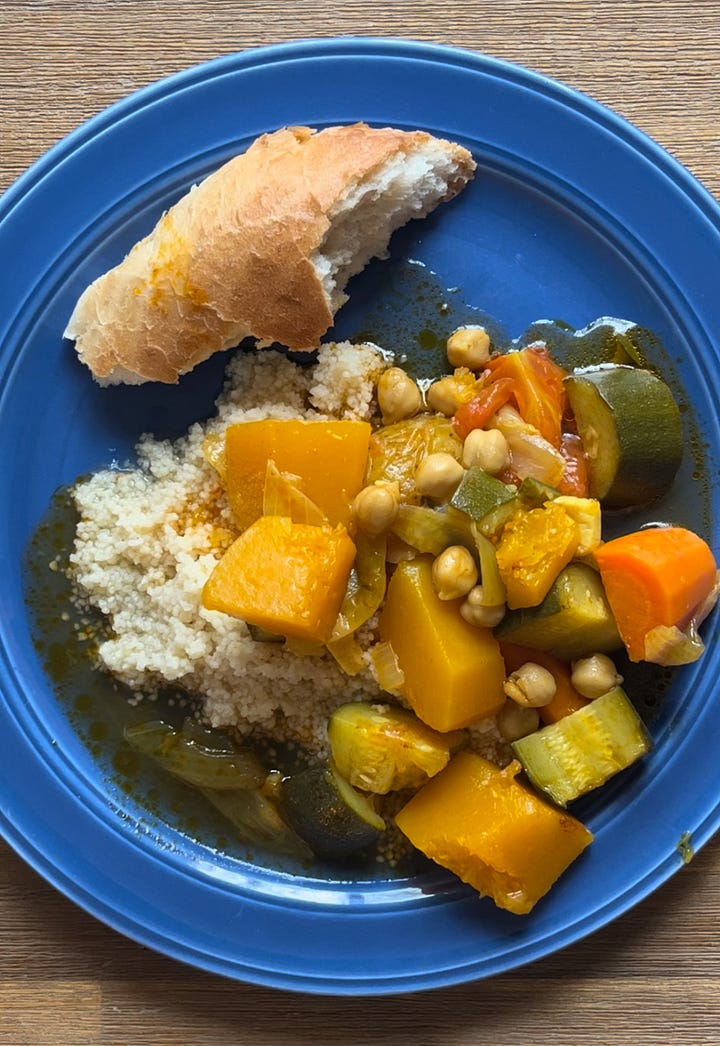
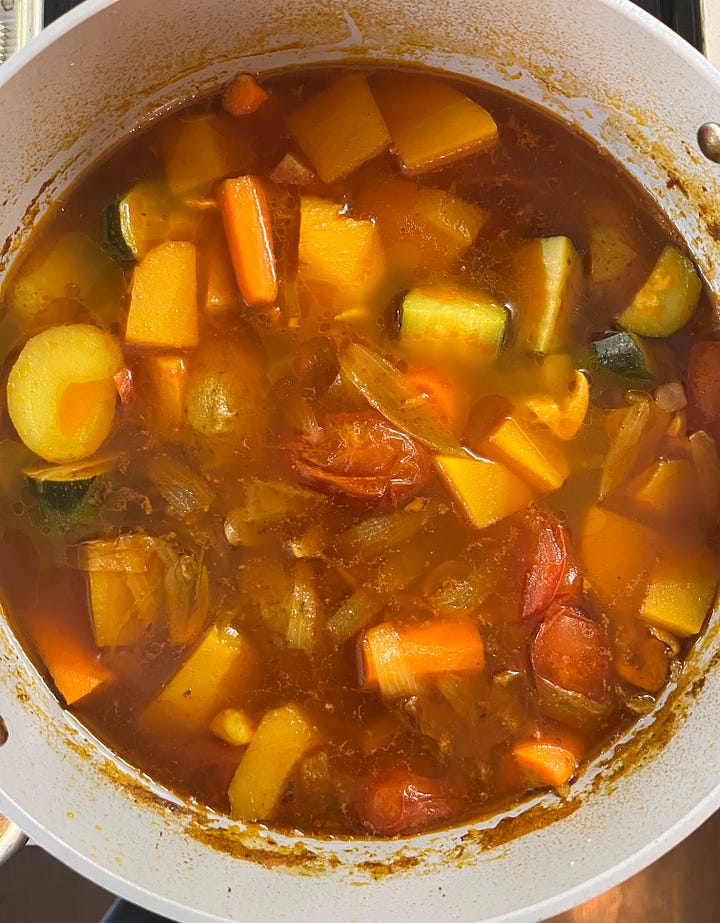
Vegetable Stew for Couscous (Zuppa per Couscous)
Okay, okay—my photos of the vegetable stew aren’t quite as gorgeous as the one Kristin took for Portico. But even when it’s looking humble and homey, it’s still a very attractive dish don’t you think? Sukkot, here we come.
Keep reading with a 7-day free trial
Subscribe to The Jewish Table to keep reading this post and get 7 days of free access to the full post archives.




